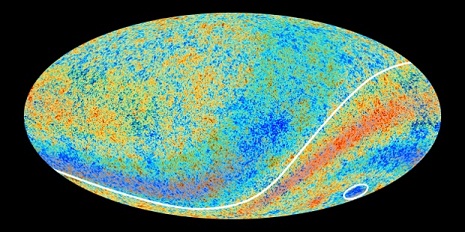The “supervoid”, as it is known, is a spherical blob 1.8 billion light years across that is distinguished by its unusual emptiness.
István Szapudi, who led the work at the University of Hawaii at Manoa, described the object as possibly “the largest individual structure ever identified by humanity”.
Its existence only emerged thanks to a targeted astronomical survey, which confirmed that around 10,000 galaxies were “missing” from the part of the sky it sits in.
Szapudi’s team was intentionally searching for the void because they believed that it could explain previous observations showing that part of the sky is unusually cool.
The so-called Cold Spot was discovered 10 years ago and has proved a sticking point for the best current models for how the universe evolved following the Big Bang. Cosmological theory allows for a bit of patchiness in the background temperature, due to warmer and cooler spots of various sizes emerging in the infant universe, but areas as large and cold as the Cold Spot are unexpected.
Prof Carlos Frenk, a cosmologist at the University of Durham, said: “The Cold Spot raised a lot of eyebrows. The real question was what was causing it and whether it was a challenge to orthodoxy.”
The latest study suggests that the Cold Spot can be partly explained by a gigantic region of emptiness at its centre, which drains energy from light travelling through it.
The supervoid is not an actual vacuum, as its name suggests, but has about 20% less stuff in it than our part of the universe – or any typical region. “Supervoids are not entirely empty, they’re under-dense,” said András Kovács, a co-author at the Eötvös Loránd University in Budapest.
The structure may sound unremarkable – hardly a standalone object even – but scientists say it is unprecedented given how evenly distributed the universe normally is at this spatial scale. “This is the greatest supervoid ever discovered,” Kovács said. “In combination of size and emptiness, our supervoid is still a very rare event. We can only expect a few supervoids this big in the observable universe.”
Previously, astronomers observing in the direction of the Cold Spot had established that there was no distant void in that part of the sky, but until now the nearer sky had not been surveyed.
The latest study used the Hawaii’s Pan-STARRS1 (PS1) telescope located on Haleakala, Maui, and Nasa’s Wide Field Survey Explorer (WISE) satellite to count the number of galaxies in a patch of sky around 3 billion light years away – relatively close in the cosmic scheme of things.
The survey, described in Monthly Notices of the Royal Astronomical Society, confirmed that there was a roughly spherical region that was far less densely populated by galaxies than the surrounding sky and that it was centred on the Cold Spot.
However, rather than solving the puzzle the latest discovery has only served to deepen the mystery. “It just pushed the explanation one layer deeper,” said Dr Roberto Trotta, a cosmologist at Imperial College London. “Now we have to figure out how does the void itself form. It’s still a rare event.”
Even more perplexing, according to Frenk, is the fact that the supervoid can only account for about 10% of the Cold Spot’s temperature dip.
“The void itself I’m not so unhappy about. It’s like the Everest of voids – there has to be one that’s bigger than the rest,” he said. “But it doesn’t explain the whole Cold Spot, which we’re still in the dark about.”
This partial explanation could point to the existence of “exotic physics”: new weird effects that scientists don’t yet know about.
The existence of an empty patch helps explain the Cold Spot because assuming the universe is expanding at an accelerating rate, photons of light would be expected to lose energy (cool) as they cross a void.
This is because the photons convert kinetic energy to gravitational potential as they travel to the heart of the void and get further from denser surrounding patches of universe – think of it as climbing a hill. In a stationary universe, the situation would be symmetrical and so the photons would regain the lost energy on the way out of the void (down the hill). In an accelerated expansion of the universe, however, everything is effectively becoming less dense as space is stretched out, so voids become relatively shallower over time. This means by the time the light descends the virtual hill, the hill has become flatter and the light cannot pick up all the energy it lost on the way in. This means the light exits with a longer wavelength, corresponding to a cooler temperature.
The observation that the Cold Spot and supervoid coincide would fit with the idea that the universe is indeed expanding at an accelerating rate, which scientists put down to forces linked to dark energy. “This is independent evidence, in case anyone doubts it, for the existence of dark energy,” said Frenk.
More about:
















































